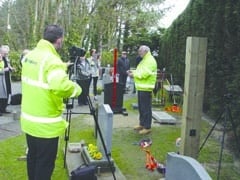The National Association of Memorial Masons (NAMM) and Anton Matthews, the maker of the StoneSafe memorial fixing system, have fallen out over a video Anton has posted on YouTube (watch it here).
You can read more about the memorial masonry side of the stone industry in the June 2014 issue of Natural Stone Specialist.
NAMM has said it will not talk further with Anton until it has taken legal advice (see the story here).
Anton made the video to show that a ground anchor memorial fixing system of the sort approved by NAMM does not work in poor soil conditions. He dug a pit and filled it with sand, then fixed a memorial in it using a ground anchor and pulled it. It pulled over at half the weight it is suppoosed to resist according to British Standard BS 8415.
Anton has called for the test method of digging a pit and filling it with sand to be adopted by the British Standard so that the test is standardised and repeatable. Currently fixing systems are tested in the ground at a cemetery.
The BSI committee that deals with the memorial fixing standard BS 8415, which Anton was invited to attend when it met earlier in the year, has asked NAMM to provide more information about the ground conditions that its tests of memorial fixing systems have been carried out in. NAMM will report back to the committee at its next meeting in June.
NAMM maintains that in the video posted on YouTube the fixing system does not fail because the memorial does not collapse and would not, therefore, cause anyone any harm.
NAMM says that in nearly 20 years since the ground anchor memorial fixing system was adopted there has not been a failure of a memorial fixed using the system. It also says that in the particularly poor soil conditions of sand that Anton created in his test, a longer ground anchor should have been used, as recommended by NAMM in its Code of Working Practice.
In response, Anton says: “Installing a memorial is a civil engineering operation and the single pin ground anchor installation is a matter of concern. A 25mm pin does very little to support a memorial in a disturbed or low strength soil condition as was shown in the video.
“The greater the diameter of the pin (or pile) the greater the stability of the memorial – this is a basic engineering principle.
“An installer forcing a pin into an unknown soil condition could be unaware it could contain unexpected voids from the back fill of the grave.
"The video clearly shows that the single pin fixing in a forward pull test when subjected to a lower force than that stipulated by British Standards (150kg) did not remain upright and, consequently, failed.
“BS 8415 of 2012 note 5, Design and construction, 5.1 general, states that new and reinstated monuments shall be designed and constructed to provide a stable structure that is serviceable and provides satisfactory performance for the life of the monument.
“The video showed that in this test the memorial failed to remain upright and therefore cannot be classed as a stable structure.
“I believe these are reasons enough to consider the pin system to be an outdated fixing method of installation and certainly not working to best practice.
“Regarding the test pit used in the video, to which NAMM takes exception, is it not simple common sense that there should be a universal, repeatable test method?
“The test pit was used after we had consulted advice in other British Standards for testing engineered structures – after all, that way the test can be carried out by anyone (test houses or universities) not just NAMM.
“I wish to remind NAMM of tests of memorial stability systems carried out by BSI-approved test organisation Southern Testing, which showed pin fixing failures in various soil conditions. The test report can be downloaded from the StoneSafe website.
“Everything we have stated is factual and backed by evidence prepared by independent experts in civil engineering who have carried out tests of systems and produced reports.
“Rather than trying to rubbish the improvements I have suggested to test methods in respect of memorial safety, NAMM should welcome these and seek to contribute to them.”

